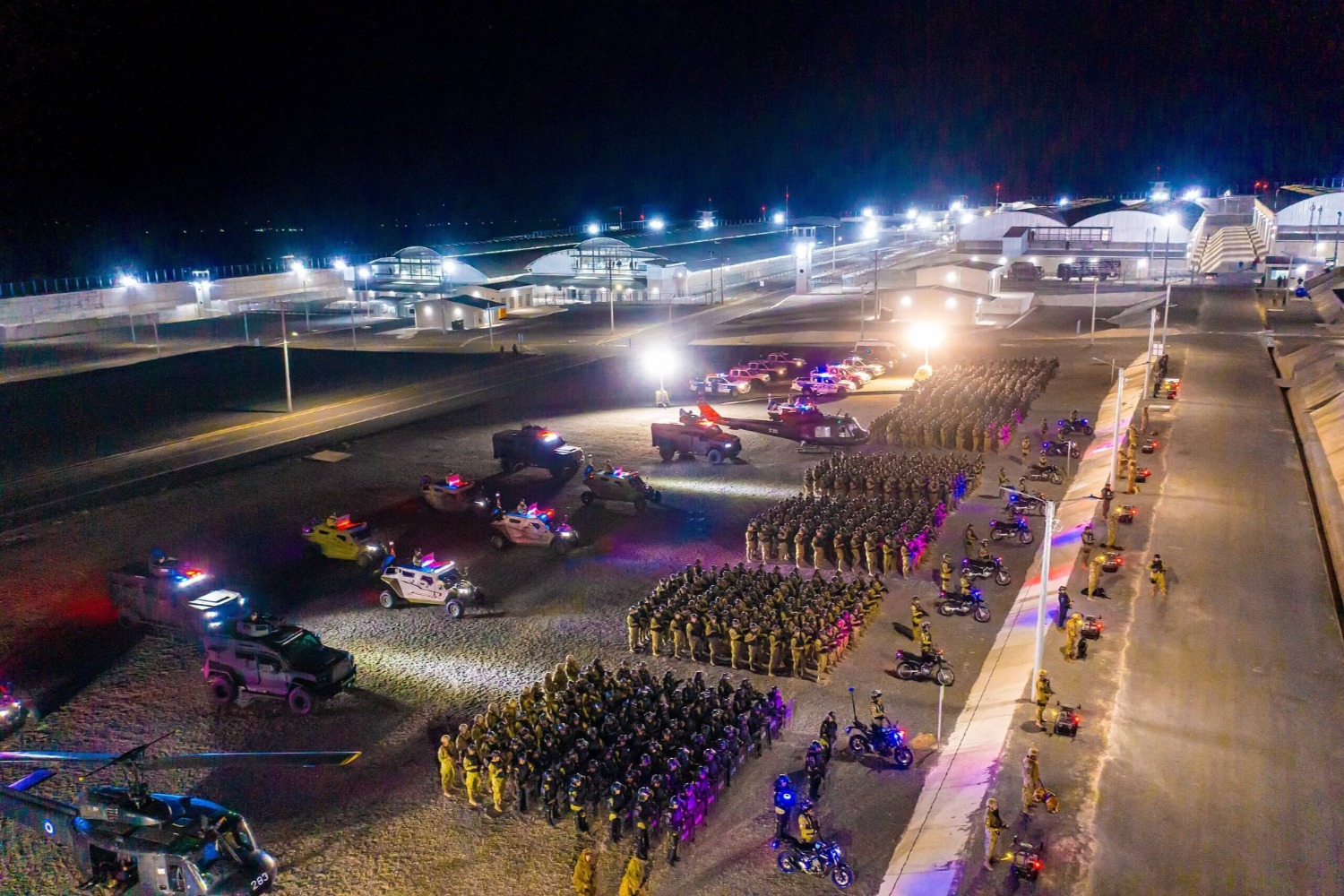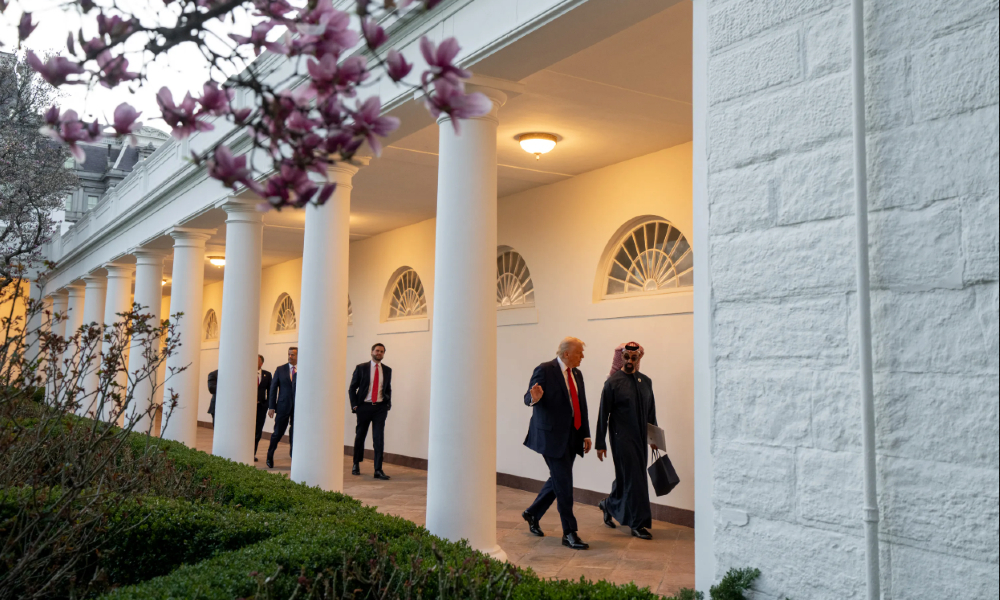The Heroism of Effective Logistics: A Dispatch from Kerem Shalom
We witnessed a moving scene today---if the loading and unloading of trucks amid looming concrete security barriers can ever really be moving: A major joint Palestinian-Israeli operation to route goods into the Gaza Strip.
We're not talking here about politics.
Published by The Lawfare Institute
in Cooperation With

We witnessed a moving scene today---if the loading and unloading of trucks amid looming concrete security barriers can ever really be moving: A major joint Palestinian-Israeli operation to route goods into the Gaza Strip.
We're not talking here about politics. The politics of the Kerem Shalom crossing are endless and complicated, with Palestinians and many international organizations decrying the tight grip Israel maintains on Gaza’s access to foodstuffs, building materials, and consumer goods, and Israel and Egypt alike restricting the flow of goods into Gaza out of fear of Hamas's use of those materials to build rockets, tunnels, and other terror infrastructure.
What's moving, rather, is the logistics---which is odd, since there's something kind of inherently unmoving about logistics. While what sort of materials get through to Gaza is a both political matter and a strategic matter, physically getting the goods into the territory---and getting Gazan produce and exports out of it---requires more than politics and high strategy. It requires a complicated on-the-ground endeavor that involves a lot of doing on both sides. And there's a group of people both on the Israeli and Palestinian sides of the line who take real risks running an elaborate joint operation to make it all happen.
We visited, toured, and talked to the Israeli and Palestinian management of the Kerem Shalom crossing---which sits at the three-way border between Gaza, Egypt, and Israel---this morning as part of a study trip to Israel for legal scholars sponsored by Academic Exchange in partnership with the Yitzhak Rabin Center. (Matt is an executive board member of Academic Exchange, which organizes educational missions and conferences related to Israeli and Middle East politics and security.)
 Getting goods into Gaza requires a lot of actions that getting goods into most territories does not require. It's much more difficult than, say, than managing a U.S.-Mexican border crossing, where one worried about smuggling and contraband, but not the possibility of physical attack on the crossing itself.
Israeli trucks can't drive into Gaza any more. But Israelis and Gaza Palestinians still trade in those goods the Israeli government allows into Gaza, and humanitarian aid still arrives through the crossing. So goods coming into Gaza have to arrive on Israeli trucks and leave on Palestinian trucks. But since Hamas has been known to use truck bombs---including at this very crossing station (which is also within sight of the spot where Israeli soldier Gilad Shalit was kidnapped), it isn't viable for Palestinian and Israeli trucks simply to pull up at some joint parking lot and load and unload each other. All the more so since one also worries about snipers firing on the site from afar---necessitating that the operation be shielded from view by large concrete barriers.
Moreover, since suicide bombing is always a possibility too, you can't have unknown Gaza workers approaching Israeli facilities either. The result would be both bombings, as Hamas took advantage of direct access to Israels, and shootings, as Israeli soldiers and guards worried about unknown faces or overreacted to misunderstandings. Moreover, the Israelis insist on inspecting inbound cargo in what is, after all, an often-hot combat zone; people being what they are and with economic incentives for black marketeering strong, drivers sometimes try to smuggle contraband goods into Gaza, as over any border. And obviously, you want to inspect goods exported to or through Israel for dangerous materials or terrorists hidden among tomatoes.
So somehow, you need a system in which goods can approach from both sides using Israeli drivers from the Israeli side and Palestinian drivers from the Palestinian side, get inspected rigorously by either side as either sees fit both for contraband and for people, and then switch trucks and drivers---all without bringing unknown Israelis and Palestinians into contact with one another.
Reasonable Israelis and Palestinians alike have an enormous interest in making some such system work. If it fails, people will get blown up. People will get shot. A great many Gazans will go hungry and will lack any capacity for normalcy in life. Rightly or wrongly, the wrath of the world will come down on Israel for that state of affairs. And the prospects for any sort of negotiated settlement---already dim---will grow dimmer still. Get this system working functionally, by contrast, and you won't create any breakthroughs---breakthroughs still require political progress---but you will save a lot of lives, you'll prevent a lot of people from going hungry or deprived of basic necessities, and you'll avoid yet another opportunity to make a bad situation worse.
And that brings us to the heroism of effective logistics.
Here's how the system works: hundreds of trucks approach from the Israeli side daily. They are unloaded by Israeli workers and their cargos rigorously inspected using a variety of methodologies. They are then loaded by a trusted cadre of Palestinian workers, contractors to the Palestinian Authority, onto a set of trucks that operate only within the crossing facility itself. They are moved across the line to the Palestinian cargo area, at which they can be loaded onto Palestinian trucks that can then leave the facility. (A Hamas checkpoint lies a few kilometers down the road.) Cargo coming from the Palestinian side is driven up to the Palestinian cargo area, loaded onto the internal trucks, moved to the Israeli cargo area, unloaded, inspected, and moved onto Israeli trucks for removal.
The work is dangerous. During the recent Gaza conflagration, both the Israelis and Palestinian workers at the facility were dealing with sniper fire and rockets. And for the Palestinian workers, there was the additional problem of getting safely to work in the morning in an evironment in which Israeli air strikes, artillery, and ground operations were all active in Gaza. Apparently, to keep the facility operating, Israeli workers at the crossing had to deconflict the movements of the Palestinian workers with Israeli air and ground forces every morning.
We don't want to claim that there's some great lesson in all of this for Palestinian-Israeli coexistence. There probably isn't. But it's worth noting that sometimes when politics fail, encouraging things can happen at the most granular of levels. Sometimes these look like high-profile people-to-people peace initiatives like Seeds of Peace. Sometimes they look like Israeli and Palestinian workers loading and unloading trucks---together and separately, each serving their own peoples when their political leaderships fail to do so.
Getting goods into Gaza requires a lot of actions that getting goods into most territories does not require. It's much more difficult than, say, than managing a U.S.-Mexican border crossing, where one worried about smuggling and contraband, but not the possibility of physical attack on the crossing itself.
Israeli trucks can't drive into Gaza any more. But Israelis and Gaza Palestinians still trade in those goods the Israeli government allows into Gaza, and humanitarian aid still arrives through the crossing. So goods coming into Gaza have to arrive on Israeli trucks and leave on Palestinian trucks. But since Hamas has been known to use truck bombs---including at this very crossing station (which is also within sight of the spot where Israeli soldier Gilad Shalit was kidnapped), it isn't viable for Palestinian and Israeli trucks simply to pull up at some joint parking lot and load and unload each other. All the more so since one also worries about snipers firing on the site from afar---necessitating that the operation be shielded from view by large concrete barriers.
Moreover, since suicide bombing is always a possibility too, you can't have unknown Gaza workers approaching Israeli facilities either. The result would be both bombings, as Hamas took advantage of direct access to Israels, and shootings, as Israeli soldiers and guards worried about unknown faces or overreacted to misunderstandings. Moreover, the Israelis insist on inspecting inbound cargo in what is, after all, an often-hot combat zone; people being what they are and with economic incentives for black marketeering strong, drivers sometimes try to smuggle contraband goods into Gaza, as over any border. And obviously, you want to inspect goods exported to or through Israel for dangerous materials or terrorists hidden among tomatoes.
So somehow, you need a system in which goods can approach from both sides using Israeli drivers from the Israeli side and Palestinian drivers from the Palestinian side, get inspected rigorously by either side as either sees fit both for contraband and for people, and then switch trucks and drivers---all without bringing unknown Israelis and Palestinians into contact with one another.
Reasonable Israelis and Palestinians alike have an enormous interest in making some such system work. If it fails, people will get blown up. People will get shot. A great many Gazans will go hungry and will lack any capacity for normalcy in life. Rightly or wrongly, the wrath of the world will come down on Israel for that state of affairs. And the prospects for any sort of negotiated settlement---already dim---will grow dimmer still. Get this system working functionally, by contrast, and you won't create any breakthroughs---breakthroughs still require political progress---but you will save a lot of lives, you'll prevent a lot of people from going hungry or deprived of basic necessities, and you'll avoid yet another opportunity to make a bad situation worse.
And that brings us to the heroism of effective logistics.
Here's how the system works: hundreds of trucks approach from the Israeli side daily. They are unloaded by Israeli workers and their cargos rigorously inspected using a variety of methodologies. They are then loaded by a trusted cadre of Palestinian workers, contractors to the Palestinian Authority, onto a set of trucks that operate only within the crossing facility itself. They are moved across the line to the Palestinian cargo area, at which they can be loaded onto Palestinian trucks that can then leave the facility. (A Hamas checkpoint lies a few kilometers down the road.) Cargo coming from the Palestinian side is driven up to the Palestinian cargo area, loaded onto the internal trucks, moved to the Israeli cargo area, unloaded, inspected, and moved onto Israeli trucks for removal.
The work is dangerous. During the recent Gaza conflagration, both the Israelis and Palestinian workers at the facility were dealing with sniper fire and rockets. And for the Palestinian workers, there was the additional problem of getting safely to work in the morning in an evironment in which Israeli air strikes, artillery, and ground operations were all active in Gaza. Apparently, to keep the facility operating, Israeli workers at the crossing had to deconflict the movements of the Palestinian workers with Israeli air and ground forces every morning.
We don't want to claim that there's some great lesson in all of this for Palestinian-Israeli coexistence. There probably isn't. But it's worth noting that sometimes when politics fail, encouraging things can happen at the most granular of levels. Sometimes these look like high-profile people-to-people peace initiatives like Seeds of Peace. Sometimes they look like Israeli and Palestinian workers loading and unloading trucks---together and separately, each serving their own peoples when their political leaderships fail to do so.
 Getting goods into Gaza requires a lot of actions that getting goods into most territories does not require. It's much more difficult than, say, than managing a U.S.-Mexican border crossing, where one worried about smuggling and contraband, but not the possibility of physical attack on the crossing itself.
Israeli trucks can't drive into Gaza any more. But Israelis and Gaza Palestinians still trade in those goods the Israeli government allows into Gaza, and humanitarian aid still arrives through the crossing. So goods coming into Gaza have to arrive on Israeli trucks and leave on Palestinian trucks. But since Hamas has been known to use truck bombs---including at this very crossing station (which is also within sight of the spot where Israeli soldier Gilad Shalit was kidnapped), it isn't viable for Palestinian and Israeli trucks simply to pull up at some joint parking lot and load and unload each other. All the more so since one also worries about snipers firing on the site from afar---necessitating that the operation be shielded from view by large concrete barriers.
Moreover, since suicide bombing is always a possibility too, you can't have unknown Gaza workers approaching Israeli facilities either. The result would be both bombings, as Hamas took advantage of direct access to Israels, and shootings, as Israeli soldiers and guards worried about unknown faces or overreacted to misunderstandings. Moreover, the Israelis insist on inspecting inbound cargo in what is, after all, an often-hot combat zone; people being what they are and with economic incentives for black marketeering strong, drivers sometimes try to smuggle contraband goods into Gaza, as over any border. And obviously, you want to inspect goods exported to or through Israel for dangerous materials or terrorists hidden among tomatoes.
So somehow, you need a system in which goods can approach from both sides using Israeli drivers from the Israeli side and Palestinian drivers from the Palestinian side, get inspected rigorously by either side as either sees fit both for contraband and for people, and then switch trucks and drivers---all without bringing unknown Israelis and Palestinians into contact with one another.
Reasonable Israelis and Palestinians alike have an enormous interest in making some such system work. If it fails, people will get blown up. People will get shot. A great many Gazans will go hungry and will lack any capacity for normalcy in life. Rightly or wrongly, the wrath of the world will come down on Israel for that state of affairs. And the prospects for any sort of negotiated settlement---already dim---will grow dimmer still. Get this system working functionally, by contrast, and you won't create any breakthroughs---breakthroughs still require political progress---but you will save a lot of lives, you'll prevent a lot of people from going hungry or deprived of basic necessities, and you'll avoid yet another opportunity to make a bad situation worse.
And that brings us to the heroism of effective logistics.
Here's how the system works: hundreds of trucks approach from the Israeli side daily. They are unloaded by Israeli workers and their cargos rigorously inspected using a variety of methodologies. They are then loaded by a trusted cadre of Palestinian workers, contractors to the Palestinian Authority, onto a set of trucks that operate only within the crossing facility itself. They are moved across the line to the Palestinian cargo area, at which they can be loaded onto Palestinian trucks that can then leave the facility. (A Hamas checkpoint lies a few kilometers down the road.) Cargo coming from the Palestinian side is driven up to the Palestinian cargo area, loaded onto the internal trucks, moved to the Israeli cargo area, unloaded, inspected, and moved onto Israeli trucks for removal.
The work is dangerous. During the recent Gaza conflagration, both the Israelis and Palestinian workers at the facility were dealing with sniper fire and rockets. And for the Palestinian workers, there was the additional problem of getting safely to work in the morning in an evironment in which Israeli air strikes, artillery, and ground operations were all active in Gaza. Apparently, to keep the facility operating, Israeli workers at the crossing had to deconflict the movements of the Palestinian workers with Israeli air and ground forces every morning.
We don't want to claim that there's some great lesson in all of this for Palestinian-Israeli coexistence. There probably isn't. But it's worth noting that sometimes when politics fail, encouraging things can happen at the most granular of levels. Sometimes these look like high-profile people-to-people peace initiatives like Seeds of Peace. Sometimes they look like Israeli and Palestinian workers loading and unloading trucks---together and separately, each serving their own peoples when their political leaderships fail to do so.
Getting goods into Gaza requires a lot of actions that getting goods into most territories does not require. It's much more difficult than, say, than managing a U.S.-Mexican border crossing, where one worried about smuggling and contraband, but not the possibility of physical attack on the crossing itself.
Israeli trucks can't drive into Gaza any more. But Israelis and Gaza Palestinians still trade in those goods the Israeli government allows into Gaza, and humanitarian aid still arrives through the crossing. So goods coming into Gaza have to arrive on Israeli trucks and leave on Palestinian trucks. But since Hamas has been known to use truck bombs---including at this very crossing station (which is also within sight of the spot where Israeli soldier Gilad Shalit was kidnapped), it isn't viable for Palestinian and Israeli trucks simply to pull up at some joint parking lot and load and unload each other. All the more so since one also worries about snipers firing on the site from afar---necessitating that the operation be shielded from view by large concrete barriers.
Moreover, since suicide bombing is always a possibility too, you can't have unknown Gaza workers approaching Israeli facilities either. The result would be both bombings, as Hamas took advantage of direct access to Israels, and shootings, as Israeli soldiers and guards worried about unknown faces or overreacted to misunderstandings. Moreover, the Israelis insist on inspecting inbound cargo in what is, after all, an often-hot combat zone; people being what they are and with economic incentives for black marketeering strong, drivers sometimes try to smuggle contraband goods into Gaza, as over any border. And obviously, you want to inspect goods exported to or through Israel for dangerous materials or terrorists hidden among tomatoes.
So somehow, you need a system in which goods can approach from both sides using Israeli drivers from the Israeli side and Palestinian drivers from the Palestinian side, get inspected rigorously by either side as either sees fit both for contraband and for people, and then switch trucks and drivers---all without bringing unknown Israelis and Palestinians into contact with one another.
Reasonable Israelis and Palestinians alike have an enormous interest in making some such system work. If it fails, people will get blown up. People will get shot. A great many Gazans will go hungry and will lack any capacity for normalcy in life. Rightly or wrongly, the wrath of the world will come down on Israel for that state of affairs. And the prospects for any sort of negotiated settlement---already dim---will grow dimmer still. Get this system working functionally, by contrast, and you won't create any breakthroughs---breakthroughs still require political progress---but you will save a lot of lives, you'll prevent a lot of people from going hungry or deprived of basic necessities, and you'll avoid yet another opportunity to make a bad situation worse.
And that brings us to the heroism of effective logistics.
Here's how the system works: hundreds of trucks approach from the Israeli side daily. They are unloaded by Israeli workers and their cargos rigorously inspected using a variety of methodologies. They are then loaded by a trusted cadre of Palestinian workers, contractors to the Palestinian Authority, onto a set of trucks that operate only within the crossing facility itself. They are moved across the line to the Palestinian cargo area, at which they can be loaded onto Palestinian trucks that can then leave the facility. (A Hamas checkpoint lies a few kilometers down the road.) Cargo coming from the Palestinian side is driven up to the Palestinian cargo area, loaded onto the internal trucks, moved to the Israeli cargo area, unloaded, inspected, and moved onto Israeli trucks for removal.
The work is dangerous. During the recent Gaza conflagration, both the Israelis and Palestinian workers at the facility were dealing with sniper fire and rockets. And for the Palestinian workers, there was the additional problem of getting safely to work in the morning in an evironment in which Israeli air strikes, artillery, and ground operations were all active in Gaza. Apparently, to keep the facility operating, Israeli workers at the crossing had to deconflict the movements of the Palestinian workers with Israeli air and ground forces every morning.
We don't want to claim that there's some great lesson in all of this for Palestinian-Israeli coexistence. There probably isn't. But it's worth noting that sometimes when politics fail, encouraging things can happen at the most granular of levels. Sometimes these look like high-profile people-to-people peace initiatives like Seeds of Peace. Sometimes they look like Israeli and Palestinian workers loading and unloading trucks---together and separately, each serving their own peoples when their political leaderships fail to do so.
Benjamin Wittes is editor in chief of Lawfare and a Senior Fellow in Governance Studies at the Brookings Institution. He is the author of several books.
Matthew Waxman is a law professor at Columbia Law School, where he chairs the National Security Law Program. He also previously co-chaired the Cybersecurity Center at Columbia University's Data Science Institute, and he is Adjunct Senior Fellow for Law and Foreign Policy at the Council on Foreign Relations. He previously served in senior policy positions at the State Department, Defense Department, and National Security Council. After graduating from Yale Law School, he clerked for Judge Joel M. Flaum of the U.S. Court of Appeals and Supreme Court Justice David H. Souter.






